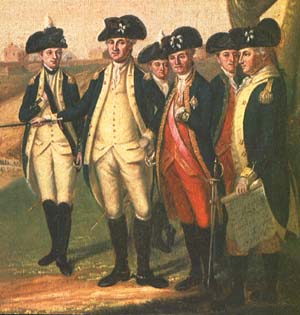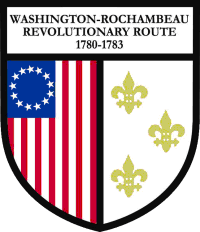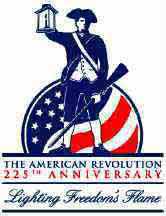The W3R
On March 30, 2009, U.S. President Barack Obama signed into law the Omnibus Public Land Management Act, which contained provisions designating the Washington-Rochambeau Revolutionary Route as a National Historic Trail |
Background on
|
The 106th Congress of the United States, at the Second Session, the Senate and House of Representatives assembled, enacted into law a bill that directs the Secretary of the Interior to complete a resource study of the 600 mile route used by the allied armies of generals George Washington and the comte de Rochambeau in their epic march that led to the victory at Yorktown, Virginia, in 1781.
The purpose of this study is to identify the scope of resources that currently, or thoses that could be added to more effectively, commemorate the historic event. In particular, the study would be a basis to identify possible, expanded involvement by the National Park Service with preservation and interpretation of the route. The bill also calls for the involvement of State and local historic activities in this assessment. Historic organizations and individuals interested in commemorating the heritage of the American Revolution should be aware of this initiative, which will have a particular focus on the states of Connecticut, Delaware, Maryland, Massachusetts, New Jersey, New York, Pennsylvania, Rhode Island, and Virginia.
|
H.R.4794 [now Public Law 106-473] |
|
One Hundred Sixth Congress
of the United States of America AT THE SECOND SESSION Begun and held at the City of Washington on Monday,
An Act |
|
To require the Secretary of the Interior to complete a resource study of the 600 mile route through Connecticut, Delaware, Maryland, Massachusetts, New Jersey, New York, Pennsylvania, Rhode Island, and Virginia, used by George Washington and General Rochambeau during the American Revolutionary War.
|
|
Speaker of the House of Representatives. [signed] President of the Senate pro tempore. [signed] Approved 9 November 2000. [Signed by the President of the United States on 4 December 2000.] |
 |
| Allied generals and some of their staff at Yorktown, Virginia, 1781. Detail of painting by James Peale, executed some time after the surrender. Images are, from left to right: marquis de Lafayette, general George Washington, general Benjamin Lincoln, comte de Rochambeau, general Chastelleux, and colonel Tench Tilghman. [Initial work held by the Maryland Historical Society. A second like work is owned by Colonial Williamsburg, Virginia. A third version is believed to be owned by descendents of Lafayette.] |
 On 16 December 1999, the W3R was organized at the Washington headquarters in Newburgh, New York. The route is essentially defined by march taken by the Continental Army of George Washington and by the French Army of comte de Rochambeau on their way to ultimate victory over British forces under the command of Maj. Gen. Charles Cornwallis in Yorktown, Va., in 1781. The route also includes the march of the French army in 1782, as it returned back north to Boston.
On 16 December 1999, the W3R was organized at the Washington headquarters in Newburgh, New York. The route is essentially defined by march taken by the Continental Army of George Washington and by the French Army of comte de Rochambeau on their way to ultimate victory over British forces under the command of Maj. Gen. Charles Cornwallis in Yorktown, Va., in 1781. The route also includes the march of the French army in 1782, as it returned back north to Boston.
 "Lighting Freedom's Flame" will be the rallying cry over the next eight years as historians from New England and the Mid-Atlantic states plan the 225th anniversary celebration of the American Revolution. The National Park Service is using the eight-year Revolutionary War anniversary both to enhance the public's understanding of the meanings and enduring legacy of the American Revolution and to protect historic resources and land associated with the war.
"Lighting Freedom's Flame" will be the rallying cry over the next eight years as historians from New England and the Mid-Atlantic states plan the 225th anniversary celebration of the American Revolution. The National Park Service is using the eight-year Revolutionary War anniversary both to enhance the public's understanding of the meanings and enduring legacy of the American Revolution and to protect historic resources and land associated with the war.
See National Park Service's website Lighting Freedom's Flame.
Note the link to their pdf format page on an 'Action Agenda for the 225th Anniversary of the American Revolution Commemorative Initiatives'.
| Background and Past Initiatives |
Following summary has been abstracted largely from parts of an unpublished article, 'Travelling on the Washington-Rochambeau- Revolutionary-Route: Future, Present, and Past' by Dr. Robert A. Selig.
Allan Forbes and Paul F. Cadman published France and New England. The work announced that an effort was to be made to mark 19 camp sites in Connecticut.
1951
1953
1957
1958
1972
1975
1976
1980
1981 |
| Status of Recent Initiatives |
The Connecticut Historical Commission published, in 1999, a report that provides a rich historical background of Rochambeau's expedition, reviews past legislative actions to commemorate the Washington-Rochambeau Route. This work furnishes a framework for other communities to follow in pursuit of listing in the National Register the entire route, from Rhode Island to Virginia. The document is Rochambeau in Connecticut: Tracing His Journey, Historic and Architectural Survey by Dr. Robert A. Selig. This work reflects the most recent, in depth historical research on the presence of the French 1781-83 military expedition to North America. Dr. Selig produced an accompanying work, Rochambeau's Cavalry: Lauzun's Legion in Connecticut 1780-1781, which describes the winter quarters of Lauzun's Legion in Lebanon (CT) and that unit's march through the state in 1781. It also reviews the important strategic planning conferences held between Rochambeau and Washington in the Connecticut towns of Harford and Wethersfield. In addition, this second work contains detailed site survey reports. Copies of these documents can be obtained from: The Connecticut Historical Commission, 59 South Prospect St., Hartford, CT 06106-1901; e-mail: [email protected]. The Washington - Rochambeau Revolutionary Route in the State of New York, 1781-1782 by Dr. Robert A. Selig. |
|
Some background on the historic march and campaign can be reviewed at the following websites: Rochambeau's Army March to Yorktown Brigade of the American Revolution
|
| |||||||||
